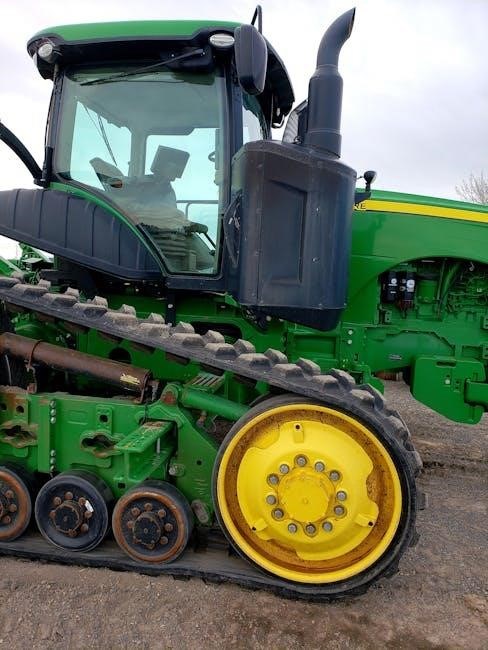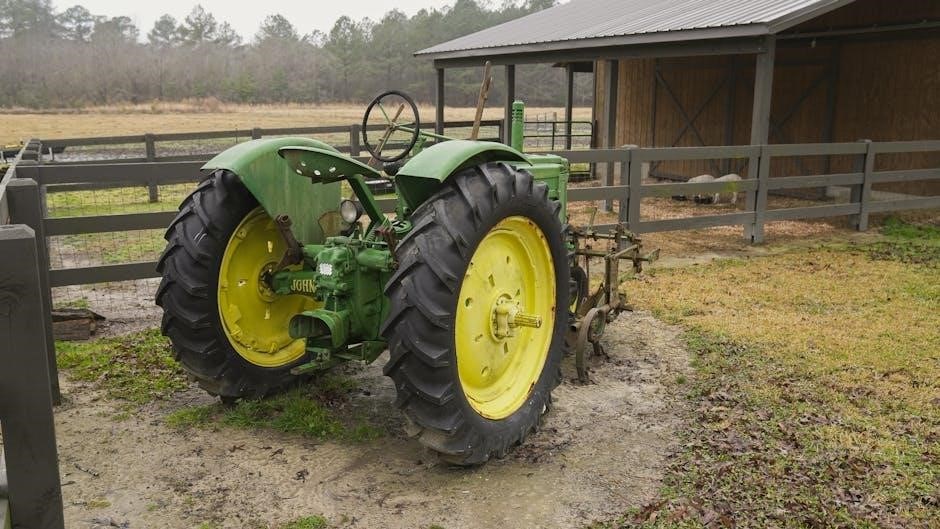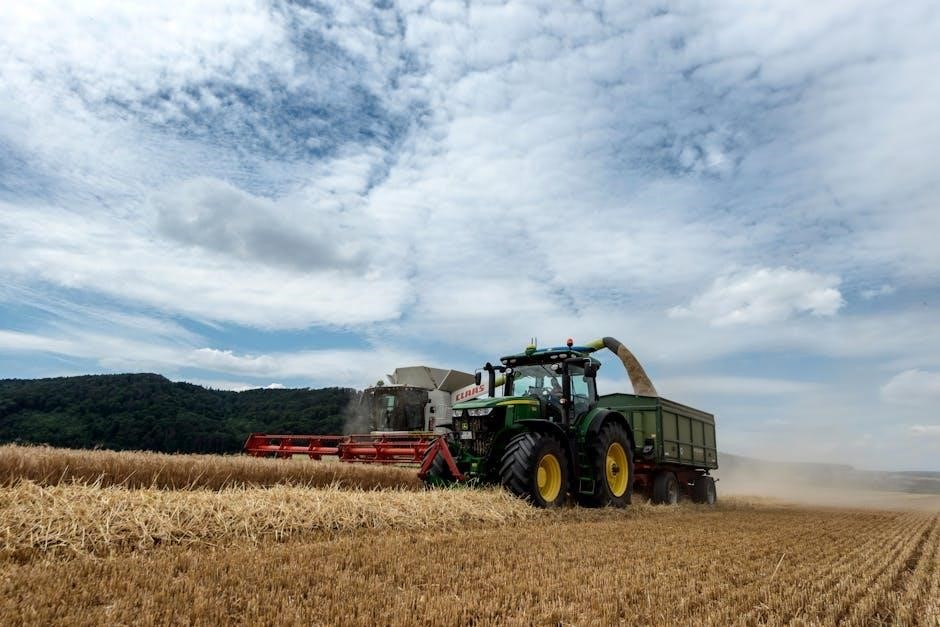john deere fault codes pdf
John Deere fault codes are essential diagnostics for identifying equipment issues. A John Deere fault codes PDF provides detailed explanations and troubleshooting guides‚ aiding operators in resolving problems efficiently.

1.1 Overview of Fault Codes in John Deere Equipment
John Deere equipment utilizes fault codes to indicate malfunctions‚ ensuring timely repairs and minimizing downtime. These codes‚ often displayed on control panels or diagnostic tools‚ are categorized by severity and system. For instance‚ codes like “10044-01” relate to DEF system issues‚ while others may indicate solenoid or sensor problems. The John Deere fault codes PDF provides a comprehensive list of codes‚ their meanings‚ and troubleshooting steps. This guide is essential for operators and technicians‚ offering a structured approach to identifying and resolving issues efficiently. By referencing these codes‚ users can address problems like engine faults or hydraulic system errors‚ ensuring optimal equipment performance and longevity. Regular use of this resource aids in proactive maintenance and reduces operational disruptions.

Understanding John Deere Fault Codes
Understanding John Deere fault codes is crucial for diagnosing and resolving equipment issues. The John Deere fault codes PDF provides detailed explanations and solutions for various codes‚ ensuring efficient troubleshooting and repairs.
2.1 What Are Fault Codes?
Fault codes are alphanumeric identifiers used by John Deere equipment to signal specific issues within the system. These codes are generated by the machine’s onboard diagnostics to alert operators and technicians about malfunctions or irregularities. They range from simple warnings to critical errors‚ each corresponding to a particular problem‚ such as sensor failures‚ hydraulic issues‚ or software glitches. The John Deere fault codes PDF serves as a comprehensive guide‚ translating these codes into understandable explanations. By referencing this document‚ users can identify the root cause of a problem quickly‚ ensuring timely repairs and minimizing downtime. This systematic approach simplifies troubleshooting‚ making it accessible for both experienced technicians and operators with basic mechanical knowledge.
2.2 Importance of Understanding Fault Codes
Understanding John Deere fault codes is crucial for efficient equipment maintenance and repair. These codes provide clear insights into system malfunctions‚ enabling quick identification of issues. By deciphering these codes‚ operators can address problems before they escalate‚ reducing downtime and costly repairs. The John Deere fault codes PDF offers detailed explanations‚ empowering users to diagnose and resolve issues effectively. This knowledge also helps in ordering the correct replacement parts and performing targeted repairs‚ saving time and resources. Regularly referencing these codes ensures optimal equipment performance‚ extending the lifespan of machinery and maintaining productivity. Understanding fault codes is essential for maximizing efficiency and minimizing disruptions in agricultural or construction operations.

Locating and Interpreting Fault Codes
Locating and interpreting John Deere fault codes involves using diagnostic tools or the John Deere fault codes PDF guide. This helps operators identify issues quickly and accurately.
3.1 How to Retrieve Fault Codes
Retrieving John Deere fault codes requires accessing the equipment’s digital display or using diagnostic tools. Operators can navigate through the control panel to the diagnostics section; Press the menu button repeatedly until the diagnostics screen appears. Select “Fault Codes” or “Service Codes” to view active or stored codes. Some models may require a USB connection to a computer with John Deere software. Refer to the John Deere fault codes PDF guide for specific instructions tailored to your machine. Always ensure the equipment is in a stationary position and follow safety protocols when retrieving codes to avoid any potential risks to personnel or machinery operation.
3.2 Understanding the Structure of Fault Codes
John Deere fault codes are structured to provide clear diagnostic information. Codes are typically alphanumeric‚ with the first part indicating the category (e.g.‚ “10044” for engine-related issues) and the second part specifying the issue (e.g.‚ “01” for a DEF system problem). The John Deere fault codes PDF explains these codes in detail‚ categorizing them by system‚ such as engine‚ transmission‚ or hydraulic faults. Each code is accompanied by a description and potential causes‚ enabling operators to identify the root issue quickly. Understanding this structure allows for efficient troubleshooting and repair‚ ensuring minimal downtime for equipment. Always refer to the official guide for accurate interpretations and solutions.

Common John Deere Fault Codes
Common John Deere fault codes include 10044-01 (DEF system issues) and 14 (insufficient solenoid current). The John Deere fault codes PDF identifies and explains these codes in detail.
4.1 List of Common Fault Codes
The John Deere fault codes PDF provides a comprehensive list of common fault codes‚ such as 10044-01‚ 14‚ and 6715‚ which relate to DEF system issues‚ solenoid current problems‚ and engine starting difficulties. These codes are categorized by their severity and system impact‚ helping operators prioritize repairs. The PDF guide also includes codes like 3320 and 4310‚ addressing specific equipment models and their unique issues. By referencing this list‚ users can quickly identify potential problems and refer to detailed explanations for effective troubleshooting and maintenance. This structured approach ensures that operators can diagnose and resolve issues efficiently‚ minimizing downtime and optimizing equipment performance.
4.2 Explanations of Frequently Encountered Codes
The John Deere fault codes PDF offers detailed explanations for commonly encountered codes‚ such as 10044-01 (DEF system issues)‚ 14 (insufficient solenoid current)‚ and 3320 (engine starting problems). Code 4310 relates to transmission or hydraulic system malfunctions‚ while 6715 indicates crank-but-no-start scenarios. Each code is linked to specific symptoms‚ possible causes‚ and recommended solutions‚ enabling operators to address issues effectively. For example‚ code 14 may require checking solenoid connections or replacing faulty components. The guide also provides troubleshooting steps for codes like 3320‚ which could involve inspecting fuel systems or ignition components. These explanations empower users to diagnose and repair issues efficiently‚ minimizing equipment downtime.

Diagnosing and Repairing Faults
Diagnosing and repairing faults involves retrieving codes‚ understanding their structure‚ and using the John Deere fault codes PDF for accurate diagnosis and efficient repair solutions.
5.1 Steps to Diagnose Fault Codes
Diagnosing John Deere fault codes involves a systematic approach. Start by retrieving the codes using diagnostic tools or the operator interface. Refer to the John Deere fault codes PDF to interpret the code structure‚ which typically includes a number and suffix. Analyze the code to identify the system or component affected‚ such as engine‚ transmission‚ or hydraulic systems. For example‚ code 10044-01 relates to a DEF system issue‚ while code 14 indicates a solenoid current problem. Consult the service manual or online resources for detailed explanations. Perform visual inspections‚ check connections‚ and test components as needed. Use specialized tools like Service Advisor or JDLink to access advanced diagnostics. Record findings and proceed with repairs based on the identified cause. Regular maintenance and updates can prevent recurring issues.
5.2 Tools and Resources Needed for Repair
Repairing issues identified by John Deere fault codes requires specific tools and resources. Essential diagnostic tools include the Service Advisor software‚ which provides detailed troubleshooting guides‚ and the JDLink system for remote monitoring. A multimeter is useful for testing electrical circuits‚ while hydraulic test kits help diagnose fluid system issues. The John Deere fault codes PDF guide is a critical resource‚ offering code explanations and repair procedures. Additional tools like wrenches‚ pressure gauges‚ and solenoid testers may be necessary depending on the fault. For complex repairs‚ consult the equipment’s service manual or contact authorized John Deere dealers for genuine parts and expert assistance. Regularly updating software and using manufacturer-recommended tools ensures accurate diagnostics and effective repairs.

Using the John Deere Fault Codes PDF
The John Deere fault codes PDF is a valuable resource for diagnosing and troubleshooting equipment issues. It provides detailed explanations of fault codes and step-by-step repair guidance.
6.1 Benefits of the PDF Guide
The John Deere fault codes PDF offers numerous benefits‚ including quick access to diagnostic information and detailed repair guidance. It serves as a comprehensive reference for operators and technicians‚ enabling them to identify issues swiftly and apply appropriate fixes. The guide is organized logically‚ making it easy to navigate and locate specific fault codes. Additionally‚ it reduces downtime by providing clear troubleshooting steps‚ ensuring equipment operates efficiently. The PDF format allows for easy sharing and accessibility on various devices‚ making it a indispensable tool for maintaining and repairing John Deere equipment effectively.
6.2 Navigating the PDF Document
The John Deere fault codes PDF is designed for easy navigation‚ featuring a clear table of contents and bookmarks for quick access to specific sections. Users can efficiently locate fault codes‚ diagnostic procedures‚ and repair instructions using the well-organized structure. The document includes a search function‚ allowing operators to find relevant information by keyword or code number. Color-coded sections and detailed diagrams further enhance readability. Additionally‚ the PDF is hyperlinked‚ enabling seamless navigation between related topics. This user-friendly layout ensures technicians and operators can quickly identify and address issues‚ minimizing downtime and maximizing productivity. The guide’s intuitive design makes it an invaluable resource for troubleshooting and maintaining John Deere equipment.

Best Practices for Troubleshooting
Adopt a systematic approach to troubleshooting using the John Deere fault codes PDF. Regularly update software‚ maintain equipment‚ and consult diagnostic guides to ensure optimal performance and minimize downtime.
7.1 Regular Maintenance to Prevent Issues
Regular maintenance is crucial for preventing issues that lead to fault codes. By following the schedules outlined in the John Deere fault codes PDF‚ operators can identify potential problems early. This includes checking fluid levels‚ filters‚ and wear on moving parts. Routine inspections help ensure that equipment runs smoothly and reduces the likelihood of unexpected breakdowns. Additionally‚ maintaining accurate records of service history can aid in troubleshooting when issues arise. A well-maintained machine not only extends its lifespan but also enhances productivity and efficiency. Referencing the PDF guide ensures that maintenance tasks are performed correctly‚ aligning with manufacturer recommendations for optimal performance.
7.2 Documentation and Record-Keeping
Proper documentation and record-keeping are vital for managing equipment health. Utilizing the John Deere fault codes PDF ensures that all diagnostic information is accurately recorded. This includes logging fault codes‚ repair actions‚ and maintenance schedules. Detailed records help track recurring issues‚ enabling proactive measures to prevent future breakdowns. Additionally‚ maintaining a service history can aid in warranty claims and provide valuable insights for long-term equipment management. Organized documentation also facilitates easier troubleshooting by allowing technicians to review past repairs and understand equipment behavior over time. By integrating the PDF guide into your record-keeping routine‚ you can streamline diagnostic processes and maintain equipment performance effectively.

Advanced Techniques for Fault Code Analysis
Advanced fault code analysis combines manufacturer guides and online forums for deeper insights‚ enabling faster diagnosis and reducing downtime with expert strategies.
8.1 Utilizing Manufacturer Resources
Manufacturer resources‚ such as the John Deere fault codes PDF‚ are indispensable for advanced fault code analysis. These official documents provide detailed explanations of codes‚ diagnostic procedures‚ and repair guidelines. By leveraging John Deere’s service manuals and diagnostic tools‚ technicians can access precise information tailored to specific equipment models. The Service Advisor tool‚ for instance‚ offers real-time data and troubleshooting steps‚ enabling faster resolution of complex issues. Regular updates from John Deere ensure that users have the latest information to address emerging problems. Utilizing these resources not only enhances diagnostic accuracy but also minimizes downtime and improves overall equipment performance. They are a cornerstone for professionals seeking reliable and efficient solutions.
8.2 Engaging with Online Forums and Communities
Online forums and communities play a vital role in fault code analysis‚ offering shared experiences and solutions. Platforms like Reddit and specialized tractor forums often have discussions on John Deere fault codes‚ where users exchange troubleshooting tips and repair advice. These communities provide real-world insights‚ helping diagnose issues that may not be covered in official manuals. For example‚ users have reported resolving codes like 10044-01 by addressing DEF system issues‚ as detailed in the John Deere fault codes PDF. Engaging with these forums fosters collaboration‚ allowing technicians and operators to learn from each other’s experiences and find alternative solutions when official resources fall short. This collective knowledge can be invaluable for tackling rare or complex problems effectively.
9.1 Summary of Key Points
The John Deere fault codes PDF serves as a comprehensive guide for diagnosing and troubleshooting equipment issues. It provides detailed explanations of fault codes‚ their structures‚ and retrieval methods. By understanding these codes‚ operators can identify problems efficiently and take corrective actions. Regular maintenance and referencing the PDF can prevent downtime and extend equipment lifespan. The document also highlights the importance of proper diagnostic tools and resources for accurate repairs. Overall‚ the John Deere fault codes PDF is an invaluable resource for ensuring optimal performance and reliability of John Deere machinery‚ helping users address issues proactively and effectively.

Additional Resources
Consult the official John Deere fault codes PDF for detailed diagnostic guides. Utilize online forums and manufacturer resources for additional troubleshooting support and updated information.
10.1 Recommended Tools and Guides
For effective fault code management‚ the John Deere fault codes PDF is indispensable. It offers comprehensive diagnostic guides‚ repair procedures‚ and troubleshooting tips. Additionally‚ John Deere’s Service ADVISOR tool provides advanced diagnostic capabilities‚ allowing users to retrieve and interpret fault codes efficiently. Online forums and communities‚ such as those mentioned in the PDF‚ are valuable for sharing experiences and solutions. Regularly updated manufacturer resources ensure access to the latest information‚ while service manuals provide detailed repair instructions. Combining these tools enhances troubleshooting accuracy and expedites repairs‚ minimizing downtime for John Deere equipment users. Always refer to official sources for reliable and up-to-date guidance.
